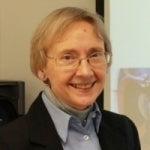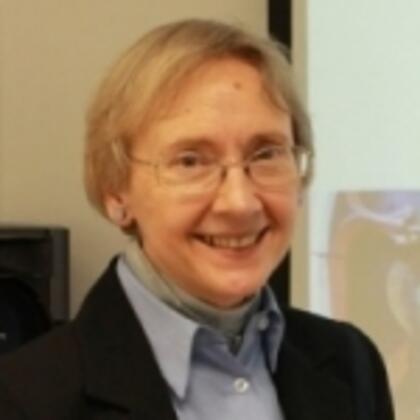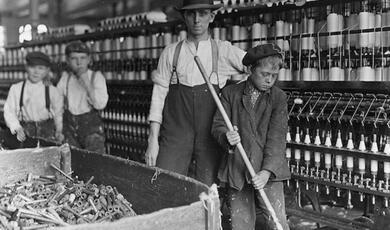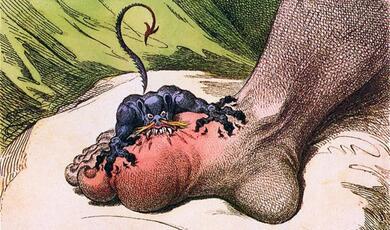Interpreting Ely Cathedral
Share
- Details
- Text
- Audio
- Downloads
- Extra Reading
Ely Cathedral demands interpretation. Why was it built on an island in the watery fens and why is it so large and elaborate?
Is the Octagon simply a splendid piece of architectural design or does it have a deeper meaning? Why is there such a large and elaborate Lady Chapel? Are the carved beasts and grotesques just products of the masons' playful fancy?
Download Text
8 October 2014
Interpreting Ely Cathedral
Dr Lynne Broughton
Spiritual tourism has a long and honourable history within Christianity. It began in the early days of persecution, when visits were made to the tombs of the martyrs on the anniversary of their death, their 'birthday into heaven'. It was given a boost by the Emperor Constantine's interest in the places where Jesus himself had walked, taught, died and risen again to life. Further destinations were added as newly converted peoples began to seek out the resting places of their own saintly heroes. By the late Middle Ages hundreds of people were taking to the roads to visit shrines, far and near, in search of spiritual or physical benefits. Undoubtedly many went along simply for the holiday or in a pretence of devotion. But there is ample evidence of griefs assuaged, ailments healed and lives transformed by what became known as pilgrimages. Ely is one of the places to which they came, and still come.
Ely cathedral has its own special character. No two cathedrals are the same, though they have much in common. All medieval churches are both functional and symbolic. They were designed to provide an appropriate setting for communal worship, for all those services which make up the Christian Liturgy. They were also intended, by their shape and decoration, to teach and to inspire. Every medieval church was designed as an image of the Heavenly Jerusalem; yet each one portrays this in its own distinct way, for heaven is a place of infinite variety. This lecture provides some insights into the way in which Ely cathedral inspires with its own unique portrayal of heaven.
The Norman church and its associated monastery were built to honour a group of local saints, and one in particular – St Etheldreda. Daughter of Anna, king of the East Angles, she was married twice; first to Tondbert and then on his death, about 655, to Egfrith, king of Northumbria. Both marriages were unconsummated. After twelve years she left Egfrith to become a nun in the community at Coldingham. She then moved to Ely where she founded a double monastery of men and women. She died in 679 and was succeeded as abbess by her sister Sexburga and then by the latter’s daughter Eormenhild. Another sister, Withburga, presided over a monastery at East Dereham in Norfolk where a holy well still marks the site of her burial.
Etheldreda’s monastery was overrun in 870 by Danish invaders who killed most of the monks and nuns and destroyed their buildings. Although a few survived and returned, we know little more of the community until it was refounded as a Benedictine monastery for men, probably in 970. Its first abbot, Byrhtnoth, brought the relics of St Withburga from Dereham, so that Ely was provided with four female saints from the same family.
Nothing survives of the pre-Conquest buildings; the Normans rebuilt the entire complex. What is particularly characteristic of the present cathedral is due largely to two periods of intense creative activity – the Norman work of the early twelfth- and the Gothic of the early- to mid-fourteenth centuries. In addition to these, the east and west ends of the cathedral were altered in the thirteenth century.
The Norman abbey church was begun in the late eleventh century by Abbot Simeon from Winchester. The ends of the transepts (the cross-wings in this and other churches with a cruciform groundplan) show clear influence from the design of the Norman work at Winchester. The enormous size of the nave, the main part of the building, may well have been due to Abbot Richard, Abbot Simeon’s successor, whose ambition it was to convert the abbey into a cathedral. He did not live to see the fulfilment of that ambition, but the abbey was given cathedral status in 1109 in the time of Abbot/Bishop Hervey. Since the nave is largely the place for the laity, such a huge structure seems hardly appropriate for the church of a monastery in a very small town. But the Normans introduced from the Continent the practice of requiring every parish in the diocese to send representatives in procession to the cathedral on the feast of Pentecost. A great deal of space was needed for these gatherings, as it still is for special occasions such as ordinations. Visitors to the cathedral on a quiet winter weekday find it hard to credit that sometimes this enormous building can be full to overflowing. Space in the nave was also needed for other processions. The Palm Sunday procession was a complex and splendid part of the cathedral’s ritual. Large numbers of pilgrims would also be expected for the feasts of local saints – in this place, most especially, St Etheldreda and her sisters - so room for them was needed, both in the nave and around the shrines.
The other great period of creative work at Ely was the fourteenth century. In response to the disastrous fall of the Norman central tower in 1322, the crossing and Choir (where the choir sings Morning and Evening Prayer) of the cathedral were transformed. In other great churches where a Norman tower had collapsed, it was usually rebuilt on its Norman foundations, but in the latest style. Here the central space was opened out into a huge, luminous octagon.
At the time of the disaster, foundations had already been laid for a large Lady Chapel - dedicated to the Virgin Mary - situated just to the north of the Choir. This also was brought to completion in an exquisitely elaborate form. This large and complex building programme was undertaken by a remarkable group of men: the bishop, John Hotham; the prior John Crauden; the sacrist Alan of Walsingham; a master mason by the name of John (probably John de Ramsey) and the master carpenter William Hurley.
The thirteenth century Early English gothic style can be seen at both ends of the building. The large 'Galilee' porch, abutting the west front, was added at that time. And at the other, east, end the Norman church was rebuilt in extended form to provide a more spacious and fitting setting for the shrines of Etheldreda and her sisters. The latter, and perhaps also the former, are closely associated with the bishop at the time - Hugh de Northwold.
Succeeding centuries have both added to and subtracted from the work of these major periods. Two exquisite chapels were built at the east end of the cathedral in the later Middle Ages. Most of the medieval imagery and some of the furnishings were destroyed in the sixteenth and seventeenth centuries; more of the medieval furnishings disappeared in the eighteenth-century re-ordering of the Choir and presbytery. Many fine furnishings were added as part of a nineteenth-century restoration programme. But much remains to show the educated and attentive observer how this medieval church was designed to teach, remind and inspire.
*****
Medieval churches were consciously and deliberately imbued with meaning; with complex, inter-related layers of Christian meanings. This was evident to the educated and was explained to the uneducated. But over the intervening centuries these meanings were eschewed or simply forgotten. All that has been left is a sense of spiritual atmosphere, more evident to some people than to others.
The service in which a church was consecrated to use for the worship of God made explicit the significance of the building. It was acknowledged that God, who cannot be contained in any work of human hands, might nevertheless deign to be present here as in the Old Testament Temple in the earthly Jerusalem. From the Book of Revelation was read St John’s vision of the Holy City, in all its shining beauty, coming down from heaven. This description fits closely the details of this cathedral, and especially the interior of the Octagon.
The true, spiritual, heaven is difficult to contemplate. As material creatures, women and men need the aid of physical things - sight, sound and movement - to help in the task. All of these are provided by this building. Walking around and through it, one has an experience of following a pilgrimage route around and through the cross of Christ. Along the way are visual aids in the form of attention-catching imagery, together with the auditory aids of music and speech. This building is not, cannot be, heaven itself. But it represents heaven and is designed to help the attentive visitor across the threshold into an experience of spiritual contemplation.
The Golden Legend, an explication of the festivals of the Church's year and one of the most famous books of the Middle Ages, completes its description of the ceremony of dedication of a church by pointing out the spiritual meaning of that ceremony: 'Now at last we speak of the consecration or dedication of the spiritual temple, which is ourselves, namely the congregation of all the faithful, built up of living and polished stones.' In St John’s vision that city is adorned with gems and many-coloured marbles. These were emulated by the use of stained glass, polychrome painting and vari-coloured stones in walls and floors. Such implicit symbolism was complemented by explicit imagery – of Christ and his mother; of saints and angels; of stories from the Bible; of innumerable creatures great and small which are part of the natural world created by God.
Romanesque and gothic Ely has lost much of its medieval imagery and most of its colouring. But enough remains for us still to experience something of the intended impact. Moreover, since the cathedral continues in use for its original purpose, new imagery is being added. It, too, illustrates aspects of the Christian message.
Church iconography always points beyond itself to the spiritual world which cannot be directly imaged. So it is that the imagery is allusive, complex, and also deliberately attractive. Beauty of form and material was used in order to help the viewer transcend its materiality.
It has taken much research by art historians and other scholars, to regain such insights into the significance of medieval churches and their decorations. Scholarly interpretation is based on evidence of various kinds. There are early Christian and medieval sermons, biblical commentaries and theological treatises, of which the most influential from the thirteenth century onwards was St Thomas Aquinas's Summa Theologiae. There are lyrics and poems, the greatest of which is Dante's Divine Comedy. Aquinas's summation of Christian theology included sections on the use and importance of church buildings and imagery. Dante presents in superb poetry the orthodox view of the Christian faith and is unequalled in his movingly imaginative portrayal of heaven. His work was known to, and read by, Chaucer. It was probably quite widely known among educated people in later medieval England. By the fourteenth century there were many manuscript collections containing selections or popularised versions of the works of the great theologians. These became progressively more widely available throughout that and the succeeding century.
Numerology, the symbolic use of numbers, is another of the means by which buildings gained significance. Recent scholarship has shown how medieval number theory worked and how highly regarded it was. Its symbolism is known to underlie architectural proportions and shapes. Numerology was so embedded in the way of thinking that the writer of the Liber Eliensis found it natural to praise the local saints in a 'fantasy-impromptu'[1] on the number four. This likened them to, among other things, the four Evangelists, the four corners of the Earth, the four rivers of Paradise, the four Gospels and the four Cardinal Virtues.
So important was numerology that some composers of polyphonic music deliberately used the architectural proportions of churches for works which were to be performed in them. The deep consonance thus obtained between building, liturgy and music was not merely esoteric. It enabled all involved, whether explicitly aware of it or not, to experience more profoundly the ordered unity of all God's creation. This may or may not heve been done at Ely, but local texts use such musical concepts as analogies. For instance, the Liber Eliensis refers to the organum (polyphony) of the prophets[2] to illustrate the way in which seemingly disparate themes in the prophetic writings of the Old Testament weave together into one message.
Studies of medieval memory training and meditative techniques make it clear that marginal images and grotesques were far from being mere doodles but added their own significance to books and buildings. Such images could be, and were, used as part of the on-going project of explaining and then deepening the faith of the beholder.
But above all, the liturgy forms the basic evidence for how the building and its imagery were understood. The service of consecration of a church was considered above. Much more is to be found in the daily Mass and offices. These, repeated in a continous yearly cycle, include most of the Bible. The Psalms were chanted in their entirety every week - most clerics knew them by heart.
In addition to this, the night office of Matins included readings from the great early theologians, of the second through the sixth centuries. Prominent are those known as the 'Four Latin Doctors', so-called because they were the most profound and influential thinkers in the western, Latin-speaking, part of the Church: Sts Jerome, Ambrose, Augustine of Hippo, Gregory the Great. Many of the readings in the night office contain material which can illuminate our approach to the church building and its imagery.
In this attempt at understanding, one needs to take the same approach as the early commentators did to the Bible text. St Augustine was in the habit of saying when about to preach on the Gospel passage which had just been read aloud: 'We have just heard the fact; now let us search for the mystery that lies hidden behind it.’
'Look then upon this Cathedral Church... imagined by men's minds, built by the labour of men's hands, working with power upon the souls of men... the visible Temple of God.'[3]
See:
Interpreting Ely Cathedral, Ely, 2008, repr. 2011
Interpreting Lincoln Cathedral: The Medieval Imagery, Lincoln, 1996
© Dr Lynne Broughton, 2014
[1]This delightfully apt phrase was suggested by Janet Fairweather, editor and translator of the Liber Eliensis, Boydell Press, Woodbridge, 2005.
[2]Liber Eliensis III, 121, p. 458.
[3]Dorothy L. Sayers; speech by the Archangel Michael at the end of The Zeal of thy House: in Four Sacred Plays, London, 1948, p.103.
This event was on Wed, 08 Oct 2014
Support Gresham
Gresham College has offered an outstanding education to the public free of charge for over 400 years. Today, Gresham College plays an important role in fostering a love of learning and a greater understanding of ourselves and the world around us. Your donation will help to widen our reach and to broaden our audience, allowing more people to benefit from a high-quality education from some of the brightest minds.


 Login
Login






